Emulsion DefinitionEmulsions are combinations of two or more liquid kinds, where one is spread throughout the other like small or even ultramicroscopic droplets. Usually, they are created by mixing liquid components, either naturally or more often with agitation, as long as the combined fluids don't contain any solubility. 
Emulsions are said to be stabilized by a few substances that form coatings at the droplet surfaces or by those that give them a certain amount of mechanical stability. Emulsions eventually divide into two distinct liquid layer types due to their instability. Milk and butter are two examples of emulsions in which fat molecules or droplets are dispersed in an aqueous solution (the dispersion of droplets of particles of an aqueous solution present in the fat). Either deleting or deactivating the emulsifying ingredient will destroy stable emulsions. An example of an emulsifying agent is when suitable outside substances are added or even when something is heated or frozen. ClarificationAn emulsion is a combination of two or more liquids that are often unable to blend and mix. It is a phrase used in chemistry. According to this definition, the dispersed portion and the dispersion medium are both liquids in an emulsion. Emulsions may be divided into two main categories: water in oil and oil in water. You can't combine the oil with water. Add a cup of water and oil to create a third cup. The oil won't mix with the other liquids; it will only float on top of the water's surface. The oil and water immediately separate again, even if they are combined. The oil and water should then be combined with a beaten egg. The oil and water have now been combined. Why is this happening, exactly? How does that work exactly? An emulsion is a combination in which the components have been combined but are not soluble in one another. Without an emulsifier, the ingredients will no longer mix or blend with any differences. The egg serves as the emulsifier for the water and oil emulsion. Emulsion: What Is It?An emulsion is a colloid made up of two or more different kinds of non-homogeneous liquids, wherein one of those liquids comprises the dispersion of the various kinds of liquids. Between Hydrophobic and HydrophilicThe terms hydrophobic and hydrophilic are essential to comprehend while discussing emulsions. Hydrophobic substances do not mix or dissolve in water. An item is considered hydrophilic if it dissolves or mixes with water. In contrast to a hydrophilic fabric, which loves water and strives to integrate as much as possible, a hydrophobic material is afraid of water and may not combine with it. Oil is a material that is hydrophobic in the first situation. For illustration, sugar dissolves in water, making it a hydrophilic substance. When hydrophobic and hydrophilic materials are together, they may quickly separate as they can no longer mate. However, there are times when we desire these two substances to join to create a third one. A fabric known as an emulsifier can help a hydrophobic and hydrophilic cloth combine. Because it possesses both hydrophilic and hydrophobic properties, an emulsifier functions, additionally, it possesses both hydrophobic and hydrophilic properties; combining both causes one to combine with the other. Examples of Emulsion
Various Emulsion Types
Emulsions may be categorized into two classes based on the characteristics of the dispersion medium and the dispersed phase. Following is a list of them. Emulsions may be categorized using the characteristics of the dispersed segment and the dispersion medium. Water in an oil emulsionA water-in-oil emulsion is one in which the dispersed portion is made up of water, and the dispersion medium is oil. These emulsions are also known as oil emulsions. These emulsions are frequently seen in cold cream and butter. Among many, cod liver oil is one example. Water and Oil emulsionA continuous emulsion segment known as an oil-in-water emulsion contains oil as the dispersed component and uses water as the dispersion medium. An example of an oil-in-water emulsion is milk. Other examples are vanish cream and other such products. Emulsions examples include
Emulsifiers and How They WorkTo truly understand this, we must first appreciate the merging process. The separation of the dispersion medium and dispersed phase occurs due to comparable particles in the emulsions coalescing to create bulkier, bigger particles. Emulsifiers stop coalescence by creating a physical barrier between the dispersed phase and the dispersion medium. It features a hydrophobic and a hydrophilic end, as seen in earlier emulsifiers like soap. As a result, they may adhere to both polar and non-polar materials. If we use sodium stearate as an example, the formula C17H35COO-Na may be shown as follows. Suppose this is introduced to an Oil in Water emulsion type (O/W), the C17H35COO. In that case, molecules surround the oil droplet with their non-polar hydrophobic/tails end (hydrocarbon chain) extending into the oil and their polar hydrophilic/heads end (carboxylate ion) into the water. This setup increases the adhesive force between the water and oil (dispersed phase) (dispersion medium). The cohesive force between oil-oil and water-water will be more similar to the freshly developed adhesive force. Thus, there won't be a tendency for the oil particles to group to produce bigger particles. Additionally, avoiding coalescence helps stabilize the emulsion. Note: The orientation of the emulsifier would be different for the Water-oil (w/o) kind of emulsion than it is for the Oil-water (o/w) type. In other words, the non-polar (hydrophobic end) tail extends to the outside while the polar (hydrophilic end) head faces inward.Theories of EmulsificationSince emulsification includes several mechanisms and processes, numerous theories accompany it (both chemical and physical). Theory of Surface TensionAccording to this idea, emulsification is a process that lowers the interfacial tension between two phases. Theory of RepulsionThe emulsifying agent creates a layer over one phase by the repulsion principle, which leads to the formation of globules. Due to the repelling effect, these compounds have on one another, they can remain suspended in the dispersion medium. Ways to Determine What Kind of Emulsions are Used1. Dilution test An o/w emulsion will remain stable when more water is added because water serves as the dispersion medium; but, if more oil is added, the emulsion will become unstable since oil and water cannot coexist. Similar to how adding water may make an emulsion type unstable while diluting it with oil keeps it stable. 2. Test for conductivity The emulsion is retained between the two electrodes while a bulb is attached to the circuit. Electricity will only flow through an o/w type of emulsion, just as it does through water, but it won't flow through a w/o emulsion. 3. Color test In this case, a water-soluble color has been added to the emulsion. In an o/w emulsion, the dispersed phase is colorless, and the dispersion medium looks red. Specifications Of Emulsions
Separation of EmulsionsTo separate emulsions into their liquid components, try one of the techniques listed below:
Applications and Uses of EmulsionEmulsions are common in many branches of science. It produces polymers, synthetic rubber, and dyes in the tanning and dyeing industries.
Emulsion-related FAQsQuestion 1: What are two examples of emulsions in daily life, and what is an emulsion? Answer: An emulsion, a colloid, is formed when two liquids that would normally not mix are mixed. The two liquids are blended to form an emulsion in one liquid. Egg yolks, butter, and mayonnaise are examples of emulsions. Question 2: What function does emulsion serve? Answer: Emulsion is a kind of paint that is frequently applied to ceilings and walls. To increase their durability, mix vinyl or acrylic with water. It has various finishes, including matt, satin, flat matt, silk, and eggshell. Question 3: Describe the functions and applications of emulsion. Answer: Emulsions are well-known in many scientific fields. It can be used in producing synthetic rubber and plastics, dyeing and tanning, and other industries.
Next TopicEnergy Definition
|
 For Videos Join Our Youtube Channel: Join Now
For Videos Join Our Youtube Channel: Join Now
Feedback
- Send your Feedback to [email protected]
Help Others, Please Share









